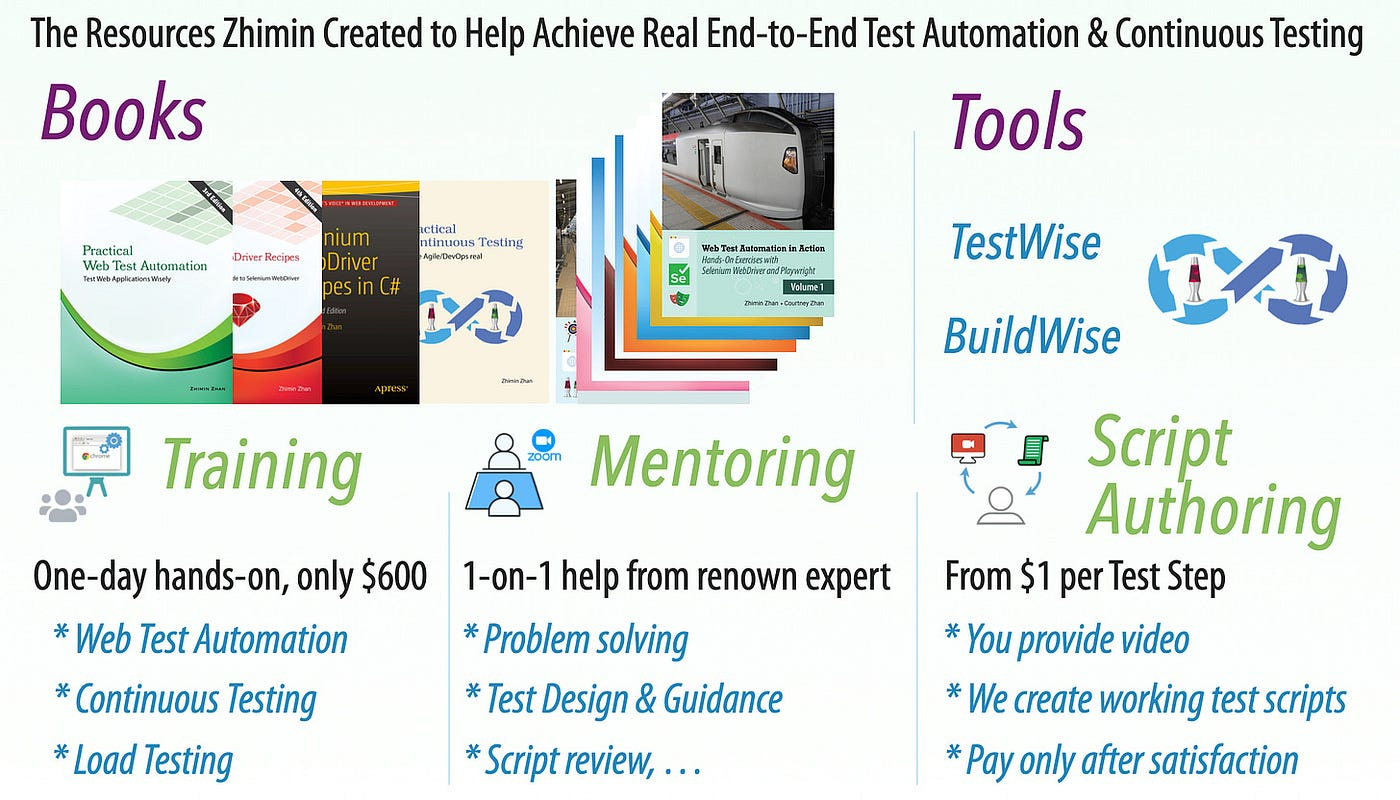Six Steps to Master End-to-End Test Automation, Part 5: Apply E2E test automation at work, gradually
Make E2E test automation useful, really useful.
Six Steps to Master Test Automation Series:
Part 1: Witness the real
Part 2: Get Motivated
Part 3: Learn Proactively
Part 4: Practise persistently *
Part 6: Learn by Teaching
Part 7: FAQ - “How long does it take to learn E2E test automation?” (upcoming)
Part 8: FAQ - “When I Would Consider Myself Qualified?” (upcoming)
Part 9: FAQ - Others (upcoming)
Any skill you spend time learning but never apply in real situations will eventually fade and won’t truly stick. Without real use, you won’t experience its benefits, grow professionally, gain promotions, … , etc.
Fortunately, End-to-end test automation, IMO, is a rare skill where you don’t need months of practice to start seeing tangible benefits at work. Moreover, the execution of automated tests is visible, meaning your manager and colleagues will notice your new abilities. This can earn you respect—since using automation demonstrates high professionalism—and open doors to new promotion opportunities.
That’s why my mentees often advance their career path quickly, like this example, “An Inspiring Story of My Highly Successful Mentee: Transitioning from a casual Non-IT worker to a Test Automation Engineer Earning a Six-Figure Salary in Just Seven Months”, Yet this remains a public secret, as most software professionals are reluctant to invest in themselves or seek mentorship.
Long-time readers know I prefer providing specific, real examples. Take my daughter, for instance (I won’t disclose my mentees, as that’s part of a mentor’s code of conduct). During university, under my advice, she used automation for her assignment presentations. Each time, lecturers and fellow students were deeply impressed. Some lecturers had award categories like ‘Most Innovative’ or ‘Best Presented,’ where winning meant full marks for the assignment. Thanks to Selenium/Appium automation running in TestWise IDE, she earned full marks for every presentation with this scheme. By the way, showcasing her E2E test automation skills helped Courtney land her first job at a FAANG company.
So, my point is that the benefits of E2E test automation is real, far real than most thought.
In this article, I will share some advice for those who have mastered the basics of E2E test automation and are about to apply it at work.
Applying E2E Test Automation at Work — Practical Advice
1. Make sure you have masters the basics.
The last thing you want is for immature attempts to bring embarrassment instead of pride. After all, over 95% of senior software engineers and architects who have tried this and have failed—sometimes multiple times.
“95% of the time, 95% of test engineers will write bad GUI automation just because it’s a very difficult thing to do correctly”.
- this interview from Microsoft Test Guru Alan Page (2015), author of “How we test software at Microsoft”
“In my experience, great developers do not always make great testers, but great testers (who also have strong design skills) can make great developers. It’s a mindset and a passion. … They are gold”.
- Patrick Copeland, Google Senior Engineering Director, in an interview (2010)
By ‘basics,’ I mean being able to develop and maintain a suite of around 25 user-story-level E2E tests for a comprehensive application. If you’re unsure, check out my daughter’s new book, “Effective Web Test Automation with Selenium WebDriver and JUnit”.
2. Keep E2E test automation just to yourself.
Use E2E test automation primarily to boost your own productivity at work. Important: run the full suite as regression testing mainly for your own benefit. Share your findings only if colleagues appreciate them. Why? Real regression testing will uncover many issues, and not all programmers are happy to see them.
A common mistake is getting so excited about the benefits of E2E test automation that you prematurely try to convince others, hoping to change the testing culture of your team, division, or company. Drop that thought—changing anything beyond yourself is difficult, and you should have known that. That said, real E2E test automation can bring huge change; one Wired magazine article even called it a ‘software revolution.’
My direct advice: use E2E test automation to excel at work, earn promotions, and increase your income 💰💰💰. Don’t worry about others, e.g., the career path in the company. Instead, consider starting a software side hustle where you can apply new methodologies for software development: E2E test automation being the most important process.
3. Stay humble and acknowledge that you are still learning
There’s a lot to learn about E2E test automation. Unfortunately, many people get misled by two extreme perspectives: some think it’s ‘very easy,’ while others believe it’s ‘extremely hard’.
Seeing you use E2E test automation at work almost certainly will trigger a variety of reactions from your colleagues.
For example, more than once, after I implemented a sizable real E2E test automation in my own project (and the team seeing the great benefits) at client companies, people (from nowhere) came and invited me to join various groups like a ‘Test Excellence Center,’ ‘Agile Transformation Team,’ or an ‘Architecture Steering Committee’. These groups had often been trying E2E test automation for years with little to show for. Their real goal of the invitation wasn’t to promote genuine test automation, but rather to draw me in and muddle the waters. This brings me to my next piece of advice.
4. Stay with own project
Yes, compliments like ‘Wow, you’re a test automation expert’ can make you lose your head. The truth is, such praise often reflects how low the bar for E2E test automation is in the industry, where many are fakers. Your real advantage came from having access to a genuine test automation engineer as a mentor.
Frankly, unless you’ve reached Level 3 of the AgileWay Continuous Testing Grading, don’t get involved in promoting test automation or in activities beyond the day-to-day testing of your own project.
5. Keep learning, access to your mentor.
Once test automation reaches a certain level of maturity, its value will be recognized by the team. But this isn’t necessarily good news—it also brings responsibility and pressure.
As you know, maintaining a sizable suite of automated tests that run frequently as regression testing is not easy. You may encounter technical challenges or issues with script stability, which can consume time you can’t afford to lose. That’s why having access to a real test automation mentor—someone who has done this extensively—is invaluable. E2E test automation knowledge and best-practices are quite transferable: the skills for testing one website largely apply to others.
I’ve seen very smart mentees quickly promoted to senior software engineer—E2E test automation can even boost coding skills too—but then lose touch with me. One of them came to lunch seeking advice, and I gave specific guidance, but he didn’t follow up or schedule mentoring sessions, nor any further contacts. A few months later, I noticed on LinkedIn that he had changed jobs. The tech stack he had insisted on but I advised him to avoid, Protractor, was announced deprecated in the same year.
Beyond quick technical help, this is another important reason to maintain access to your mentor, the next piece of advice.
6. Be aware of political games
Over nearly three decades in the software industry, across various roles, I’ve seen that E2E test automation and CI/CD are often the areas where office politics play out the most. In fact, the majority of senior engineers and managers may hope you fail, even if they say otherwise, or worse, sabotage behind your back.
Check out these three articles:
A Software Architect Attempted to Undermine Continuous Testing
An IT Graduate’s Frustration with a Fake ‘Senior Test Automation Engineer’
Chinese Idiom Stories for Software Professionals: #02 Lord Ye Loves Dragon (葉公好龍)
Ask your mentor for guidance on spotting early warning signs and avoiding potential traps.
Related reading:





